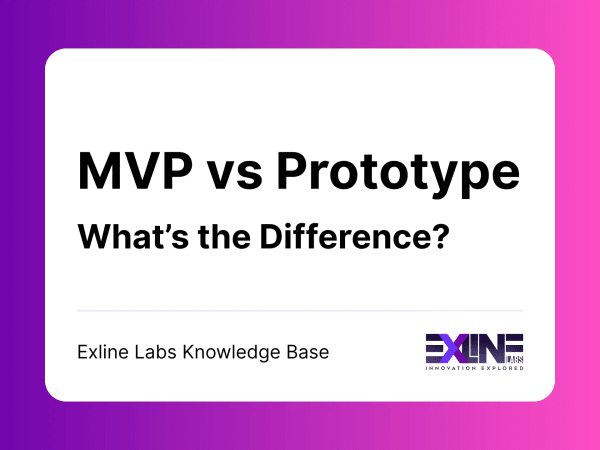How to Build an MVP (Without Wasting Time or Money)

Building a full product from day one is a high-risk move. Smart startups start with an MVP, a Minimum Viable Product, to test the market, gather feedback, and pivot if needed. This article gives you a step-by-step playbook to build your MVP the right way, without wasting time, money, or months of development.
Date Published
06 Nov 2025
Date Updated
20 Nov 2025
Written By
Exline Labs Team
Reading Time
3 min read
Service Type
MVP DevelopmentIntroduction
Building a full product from day one is a high-risk move. Smart startups start with an MVP, a Minimum Viable Product, to test the market, gather feedback, and pivot if needed.
This article gives you a step-by-step playbook to build your MVP the right way, without wasting time, money, or months of development.
Step 1: Define the Core Problem
Every great MVP starts with a single, painful, real-world problem.
Ask yourself:
- What’s the one thing my target user is struggling with?
- What’s the smallest feature I can build to solve that?
- Is it something people will pay for, or need urgently?
Example:
Instead of building a full HR platform, start with a simple leave request tracker.
Step 2: Identify Your First Target User
You don’t need to please everyone. Focus on a narrow, well-defined persona.
Good MVP personas are:
- Easy to reach and interview
- Already experiencing the problem
- Willing to try new solutions
Start with one user group. e.g., “HR managers in startups with 10–50 employees.”
Step 3: Prioritize Core Features
Ask: “What’s the minimum we need to solve the problem?”
Use a framework like MoSCoW to sort:
- Must-have
- Should-have
- Could-have
- Won’t-have
Build only the must-have features for your MVP. Nothing else.
Step 4: Choose a Development Approach
You have multiple ways to build:
| Method | Best For |
| No-code tools | Early validation, limited budget |
| Design prototypes | Pre-dev user testing |
| Coded MVP | Scalable apps with specific logic |
| MVP agency | Expert team, fast turnaround, no hiring overhead |
Exline Labs helps founders choose the right tech and tools based on their timeline and budget.
Step 5: Build & Test Fast
Aim for a build time of 2–6 weeks.
During this phase:
- Use agile sprints
- Stay focused on scope
- Avoid shiny feature creep
Test early. Get feedback. Iterate before scaling.
Step 6: Launch Soft (Then Listen Hard)
Don’t wait for perfection. Launch to a small group of early users.
Use their feedback to:
- Validate or reject assumptions
- Fix usability issues
- Plan your V2
Focus on learning, not vanity metrics.
Step 7: Prepare for Pivot or Scale
Once you’ve launched:
- Analyze data and user feedback
- Refine your roadmap
- Decide to pivot, expand, or seek funding
The MVP is only the beginning and the goal is to find product-market fit, fast.
Have any Questions?
How do I know what features to include in my MVP?
Start with the smallest set of features that solve your target user’s core problem. Use frameworks like MoSCoW or user journey mapping.
Can I build an MVP without a tech team?
Yes. You can use no-code tools or work with an MVP development agency like Exline Labs.
How long should an MVP take to build?
A typical MVP build takes between 2–6 weeks, depending on complexity.
Should I build a mobile or web MVP first?
Unless you specifically need mobile-only functionality, web MVPs are faster and more flexible.
How much should I budget for an MVP?
MVP costs range from £3,000–£20,000 depending on scope, tech, and team.
Do I need a design before building an MVP?
Yes. Even a basic wireframe or prototype improves build speed and clarity.
Can I test my MVP without launching publicly?
Yes, you can launch a private beta, use a staging environment, or manually demo the product.
What if users don’t like my MVP?
That’s great - you’ve learned something early. Use the feedback to pivot or refine.
Can I raise funding with just an MVP?
Many investors prefer to see an MVP with traction before committing. It shows you’re serious and capable.
How does Exline Labs help with MVPs?
We guide you from idea to launch, validating your concept, building the core product, and helping with scale.


